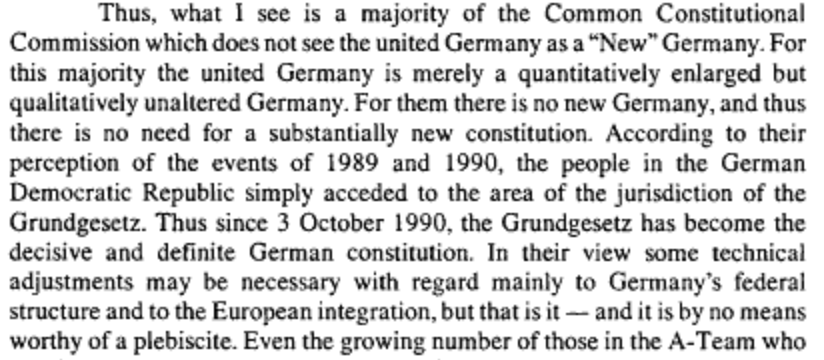Happy 70th birthday Grundgesetz! It’s often called the German Constitution, but the Basic Law was not actually meant to serve as a full constitution for the newly created Federal German Republic in 1949.
The Grundgesetz assumed that at some point it would be superceded by a constitution that would be “freely adopted by the German people.” The goal of reunification was also written into the Basic Law.
In East Germany, there were two constitutions – one in 1949, which preserved the appearance of a liberal constitution, and a “socialist constitution” from 1968 (adopted by a national plebiscite).
In 1990, after the fall of the Berlin Wall, there was an effort to create a new constitution for a German Democratic Republic. This was created by a group of dissidents/reform communists at the Central Round Table and aimed to combine liberal democracy with a strong social state
When the GDR had its first competitive elections in 1990 and unification appeared on the horizon, the idea of creating a new constitution was sidelined. The democratic GDR constitution was abandoned by the newly elected CDU-led govt in the East with support of the SPD.
When unification came, the GDR was absorbed into the Federal Republic under Art. 23 of the Grundgesetz. Although the Grundgesetz itself allowed for a new constitution approved by the German people, this was put aside.
German Unification was deemed the extension of the constitutional space of the Grundgesetz. From Uwe Thaysen “A New Constitution for a New Germany?”
So while in 1949, the Grundgesetz was seen as a temporary measure until German reunification, the actual reunification of East and West in 1990 through the absorption of the GDR acted to solidify the GG as the lasting constitution of Germany.
If you want to read more about the 1990 GDR constitution that never came about, check out this post on historical alternatives to reunification as it happened https://historyned.blog/2015/10/07/the-unthinkable-and-the-inevitable-german-reunification-25-years-later/">https://historyned.blog/2015/10/0...
And if you want to know more about the plebiscite on the East German constitution in 1968 and generally how voting and elections worked in the GDR, check out https://historyned.blog/2016/04/10/more-than-just-an-oxymoron-democracy-in-the-german-democratic-republic/amp/">https://historyned.blog/2016/04/1...

 Read on Twitter
Read on Twitter









